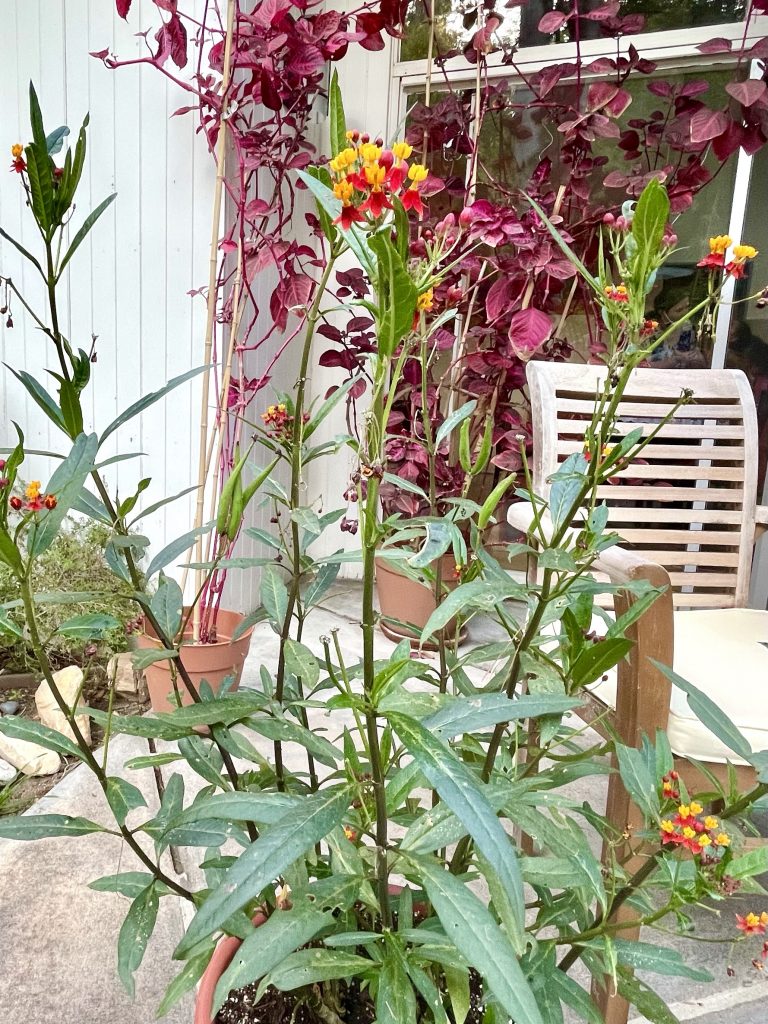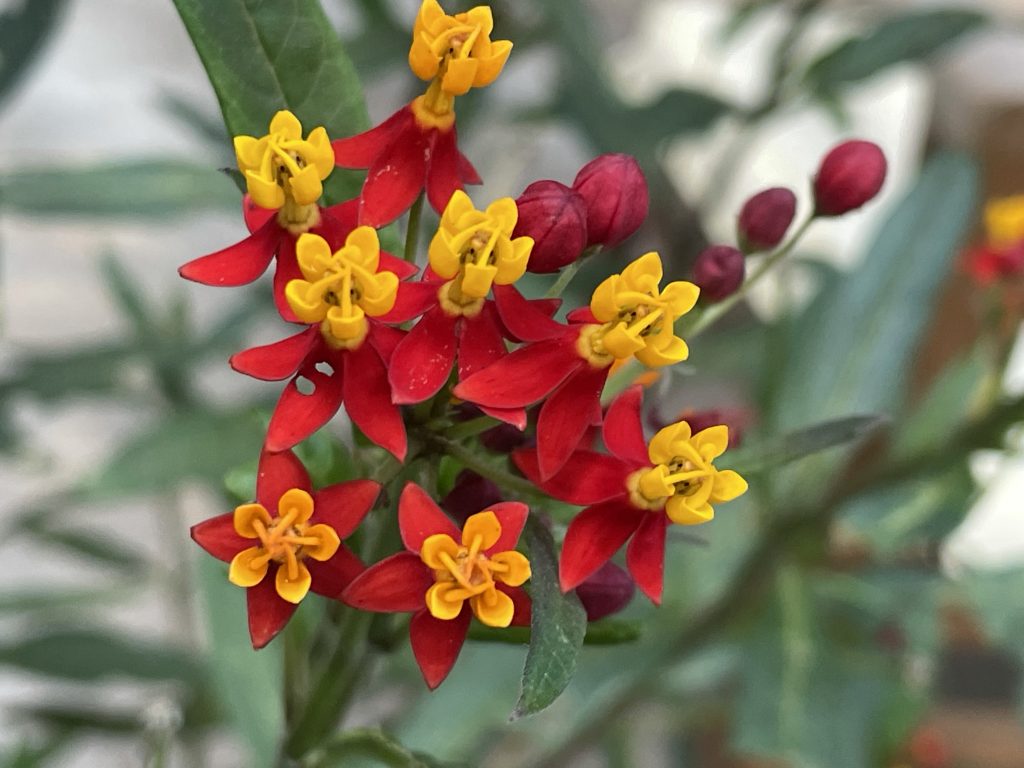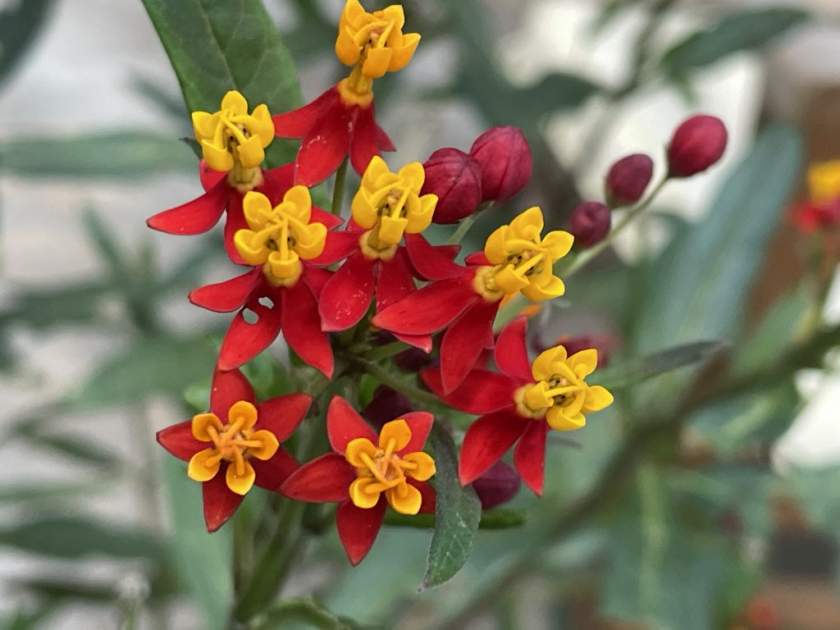Asclepias curassavica, commonly known as Bloodflower or Tropical Milkweed, is a fascinating plant that belongs to the Apocynaceae family. It is an evergreen sub-shrub native to the Caribbean, South America, Central America, and Mexico. This plant is known by various names including Indian Root, Matac, Matal, Bastard Ipecacuanha, Wild Ipecacuanha, Scarlet Milkweed, Cotton Bush, Hierba de la Cucaracha, Mexican Butterfly Weed, Sunset Flower, and Swallow Wort.
One of the notable characteristics of Asclepias curassavica is its ability to thrive as a container plant. It can be grown in pots and is suitable for gardens, patios, and even indoor settings. When planted outdoors, it typically reaches a height of about 4 feet or 1.2 meters.
The leaves of Asclepias curassavica are lance-shaped and deep green, arranged opposite each other on the stem. Like other members of the Milkweed family, this plant produces a milky sap. It blooms during the summer and autumn seasons, displaying terminal umbel-like flowers. The flowers are orangish-red in color and adorned with a bright yellow corona that resembles an additional set of petals. Following the flowers, ovoid-shaped fruits appear, reaching a length of approximately 8 cm or 3 inches.

To successfully grow Asclepias curassavica, it is recommended to provide it with full sun exposure. The plant thrives in moist, loamy, and fertile soil that is well-drained. It can be propagated through methods such as seed sowing, division, or basal cuttings. Asclepias curassavica is generally resistant to diseases, but it is important to watch out for whiteflies, particularly when the plant is kept in a greenhouse.
How to grow Asclepias curassavica:
One of the notable qualities of this plant is its ability to attract bees and butterflies, making it an excellent addition to pollinator gardens. In fact, Asclepias curassavica is specifically known to attract Monarch butterflies, as they lay their eggs on its leaves. Additionally, this plant is considered deer-resistant and rabbit-resistant.
Asclepias curassavica thrives in full sun exposure. It requires at least 6 hours of direct sunlight each day to ensure healthy growth and abundant flowering. The ideal soil for Asclepias curassavica is moist, loamy, and fertile, with good drainage. It is important to avoid waterlogged or heavy clay soils, as they can lead to root rot. If your soil is heavy, you can improve drainage by amending it with organic matter, such as compost or well-rotted manure.

Watering:
While Asclepias curassavica is relatively drought-tolerant once established, it is essential to provide regular watering during its initial growth phase and in hot, dry periods. Water deeply, allowing the soil to dry slightly between watering sessions. Avoid overwatering, as excessive moisture can lead to root rot. Asclepias curassavica generally doesn’t require heavy feeding. However, you can apply a balanced, slow-release fertilizer in early spring to provide essential nutrients for healthy growth. Follow the manufacturer’s instructions for dosage and application methods.
Pruning is not mandatory for Asclepias curassavica, but it can help maintain its shape and promote bushier growth. Prune back the plant in early spring before new growth emerges. Remove any dead or damaged branches, and consider cutting back the plant by one-third of its height to encourage branching and fuller growth.
Propagating:
Asclepias curassavica can be propagated through different methods. Seeds are the most common and reliable option. Collect ripe seed pods and break them open to release the seeds, which can then be sown in a well-draining seed-starting mix. Keep the soil consistently moist until germination occurs. Division and basal cuttings are also viable methods for propagating this plant.
Asclepias curassavica is generally resistant to most pests and diseases. However, keep an eye out for whiteflies, especially if the plant is grown in a greenhouse or in close proximity to other infested plants. Regular monitoring and prompt action, such as spraying with insecticidal soap or using natural predators, can help control whitefly populations.
Asclepias curassavica is highly attractive to bees and butterflies, particularly Monarch butterflies, which rely on it for egg-laying. To encourage these beneficial insects, avoid using pesticides on or near the plant. Providing a water source, such as a shallow dish with pebbles, can also attract butterflies.
Remember, Asclepias curassavica is considered an invasive species in some regions, particularly where it is not native. If you live in an area where it is not recommended for cultivation, consider using native milkweed species to support local ecosystems and pollinators instead.
In tropical and milder climates, Asclepias curassavica can flower throughout the year, adding vibrant splashes of color to the landscape. It is a visually appealing plant with its striking flowers and is cherished for its ecological role in supporting pollinators, particularly Monarch butterflies.




